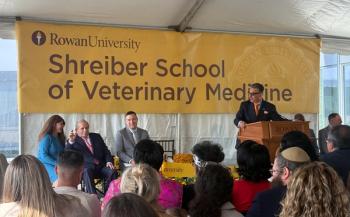
Mourning the loss of a pet and patient: understanding grief and the need for support (Proceedings)
To further understand the loss and need for support after a pet or patient dies, the veterinary professional must have an understanding about the human-animal bond. This relationship between humans and pets dates back to the beginnings of civilization. The benefits to owning a pet can be emotional, social and physical.
To further understand the loss and need for support after a pet or patient dies, the veterinary professional must have an understanding about the human-animal bond. This relationship between humans and pets dates back to the beginnings of civilization. The benefits to owning a pet can be emotional, social and physical. Specially trained canines offer protection, assistance, independence, and improve the quality of life for many individuals with physical and mental challenges. Pets are companions, who love unconditionally. They often assume the role of protector, confidant, soul mate, co-worker and soldier. Pets are happy to see their owners at the end of the day regardless of how the day was going up to that point. They make people laugh and are considered family members; sharing in the daily routines of their human companions. Some pets share their owner's furniture and may be the recipient of gifts for special occasions along with the rest of the family. It is these normal routines and occasions that are missed so greatly when and animal dies. The silence in the house can be deafening. The relationship with the pet varies and often the death of a pet has other significant meaning to the owner. For example, the cat owner whose 20 year old cat first came to her as a teenager and moved through her life into adulthood will not only be saying goodbye to a dear childhood friend, but also her youth. A pet may be the only connection to a dear departed loved one and once the pet passes, the family will mourn the animal companion and the connection that the pet represented to their loved one.
The death of a pet is a difficult experience for pet owners. It is a time of true grieving. Family or friends don't always understand this grief and often the loss of a pet is trivialized and viewed as insignificant. The workplace does not understand the grief associated with losing a pet. It's generally frowned upon when an employee takes time off for bereavement. Often owners are embarrassed about their feelings of sadness over the loss of their beloved non-human companion. These feelings and lack of support can create a very isolating environment for the pet owner. This lack of support can certainly delay healing by prolonging the grieving process.
The veterinary professional may have found the love of animals to be the catalyst to their career choice. Because of euthanasia and the short life span of the patient, veterinarians and staff experience a stress unknown to other medical practitioners in United States. Many veterinarians and staff have not been taught counseling skills, the process of grief, or the normal parameters of emotions experienced during loss. The veterinary professional often needs help sorting out their own emotions while responding appropriately to the client's needs. Educating the veterinarians and their staff about grief, self-care techniques, and appropriate client interventions, as well as emotional support, will help them develop coping skills and establish comfortable boundaries. By learning to help the client, the veterinary professionals will learn to help themselves.
When dealing with grief, the pet owner and veterinary professional must first understand what grief is and how it impacts an individual. Mourning the loss of a pet is unique to each individual and knows no timetable. Understanding the process of grief and mourning can offer assistance in dealing with loss and healing. Grief is deep mental anguish arising from bereavement. Mourning is a time when an individual feels or expresses their sorrow over a loss. The period of mourning is unique unto each individual's loss. In the 1960's Dr. Elisabeth Kubler-Ross brought the subject of death and dying out in the open and her groundbreaking and best-selling book, On Death and Dying, published in 1969, was based on interviews with dying patients. Dr. Kubler-Ross identified five stages of grief: denial, anger, depression, bargaining and acceptance. Each person going through the grieving process passes through these stages as they move forward. While guilt isn't technically a stage or phase of grief, it denotes mentioning, as it is an emotion that weighs heavily on every owner that has lost a pet. Owners will second guess the type of care they chose; wonder if they "missed something" that may have served to assist in an earlier diagnosis. Often, they wonder if they should have euthanized their pet earlier or did they do it too soon. Guilt is very counterproductive and stalls the healing and closure process. Guilt hits many owners with full force.
The loss of a pet affects the whole family and not just the adult caregivers. Children understand things a lot more than society is willing to acknowledge. More often than not, the loss of a pet is a child's first experience with death. This is an important time for parents and other adults to teach children how to express grief in emotionally healthy ways free of embarrassment and shame. The age of a child and level of cognitive development has a direct connection to what the child will experience when their pet dies. The veterinary professional should advise owners to seek assistance from reliable resources and a mental health care professional for guidance in this area.
Ways to cope with grief
The veterinary professional can be instrumental in helping the client heal. Being available to listen to the client is extremely beneficial. Grieving people need to verbally express their feelings and know that they have been heard and understood. Provide grief information resources for clients such as brochures, grief support hotline telephone numbers, and list of books to read, websites, and a list of local pet loss support groups. Referring the grieving pet owner to a therapist or pet loss support group lets the client know that you care. If there is no grief support group available, start one at your practice. The grieving pet owner needs to take care of him or herself, taking the time to eat and rest. For some, prayer and meditation is very healing. Keeping busy by visiting with friends, especially ones that have pets can be very therapeutic as well. Fellow pet owners are a great source of comfort and support. They understand the special relationship that has been severed and lost.
While often ignored or dismissed, the veterinary staff experiences grief. In the past and to an extent even today, acknowledging grief in association with the profession is viewed as a sign of weakness and poor job performance. If this grief is not embraced and worked through, however, it can lead to depression, disconnecting from ones feelings and "burn out". Veterinary professionals need to take better care of their health and be sure to see the humor and joy in the work they do. Debriefing and discussing pet hospice and euthanasia cases can be very cathartic.
The grief of the animal companion
The surviving animal companion to the deceased pet may grieve for the animal that has died. The veterinary professional must educate owners about animal companion grief and the fact that it is real and may or may not have serious health consequences. The grieving owner may unintentionally miss these signs of grief, which could lead to the pet becoming ill. Owners often notice changes in the surviving pet's behavior. These changes can be subtle or quite obvious. For example, owners may notice that the pet is clinging close to them and may appear unsettled; wandering around searching for their animal companion. Perhaps the pet begins sleeping in the deceased pet's bed when they had not done so before. The owner should watch closely for depression, lethargy and a decrease in appetite. If these signs occur, they should be encouraged to contact the practice. It is always better to be safe than sorry. To ease the loss for the surviving animal companion, it may be helpful to allow the surviving pets to see and smell the remains of their companion. If the pet is euthanized or died on their own at the veterinary practice, then it is suggested to bring the blanket or towel the pet had contact with when they died home to the other pets. Animals have a keen sense of smell much more than humans. It is thought that the changes in body chemistry brought about by death will be detected by the animal companion and with it the understanding that their buddy is gone.
Remembering and honoring a beloved companion animal
Anyone that has lost a loved one, whether an animal or human companion, knows that when it's all said and done, the only thing that remains are lessons learned and memories. These memories are often bittersweet to recall just after a loss, but over time these memories grow sweeter and can be recalled with happiness and less sadness. Celebrating these memories can be very healing for the grieving pet owner and should be encouraged by the veterinary professional. A few simple gestures to remember the beloved pet and patient include:
• After euthanizing the pet, make a paw or hoof print in clay for the owner.
If providing cremation service for the pet, save a snip of fur to be returned to owner with the remains.
• If the practice is on a budget, send a condolence card to the owner with a pack of "Forget Me Not" seeds to plant in memory of the pet.
• Make a donation on behalf of the patient to a shelter or veterinary school
• Journaling or writing a poem is a good way for the owner to express their feelings
• Owners can chronicle pet's life through pictures or video
• Families can create a special memory box and fill it with special mementos such as a cat's collar, I.D. tags, the shoes from an equine companion, toys, and pictures.
• Having a portrait done from a favorite photo of the pet.
• Planting flowers or a tree in a pet's favorite place in the yard.
• Having a wake or burial ceremony and placing a statue or nameplate at the gravesite.
• Volunteering at an animal shelter. Giving back to those in need can be very therapeutic.
How the veterinary professional responds to the death of a beloved pet and patient speaks volumes about the kindness and integrity of the practice and honors the profession. No matter how long the veterinary team has cared for a pet, the one true thing that an owner will remember was how the team cared for their pet before, during and afterward of the dying or euthanasia process.
Remembering "Polly" November 28, 1979 – May 15, 2000
Then a woman said, Speak to us of Joy and Sorrow.
And he answered: Your joy is your sorrow unmasked.
And the selfsame well from which your laughter rises was oftentimes filled with your tears.
And how else can it be?
The deeper that sorrow carves into your being, the more joy you can contain.
Is not the cup that holds your wine the very cup that was burned in the potter's oven?
And is not the lute that soothes your spirit, the very wood that was hollowed with knives?
When you are joyous, look deep into your heart and you shall find it is only that which has given you sorrow that is giving you joy.
When you are sorrowful look again in your heart, and you shall see that in truth you are weeping for that which has been your delight.
Kahlil Gibran
"The Prophet"
Bibliography and References
Abington Memorial Hospital, Home Care Hospice Training Manual. Fall 2002. pp. 1-7, 39-41.
Butler, Carolyn. 2002. Argus Institute, Colorado State University. "Grief Support Techniques in a Bond-Centered Practice". Proceedings for the Tufts Animal Expo, Boston MA
Carmack, Betty J. 2003. Grieving the Death of a Pet. Minneapolis, MN: Augsberg Fortress, pp.5-17, 80-119.
Clough, E. And J. Clough. 1998. "Helping Clients Say Good- bye: Hospice Care for Pets". Proceedings for FasTrack To a Better Practice, Baltimore, MD: AVMA Convention, pp. 19-43.
Colorado State University, Argus Institute for families and Veterinary Medicine, 300 W. Drake Road, Fort Collins, Colorado, 80523.
Downing, Robin. 2000. Pets Living with Cancer: A Pet Owner's Resource. Colorado: AAHA Press, pp. 81-103.
Guidelines for Veterinary Hospice Care. March 2007. American Veterinary Medical Association, Schaumburg, IL.
Gaynor James S. and William W. Muir III. 2002, 2009. Handbook of Veterinary Pain Management, 2nd. Edition, St. Louis, MO: Mosby, Inc. An affiliate of Elsevier Inc. pp. 2-12, 57-77, 505-600.
Hodgson, Harriet and Lois Krahn, MD. 2004. Smiling Through Your Tears: Anticipating Grief. North Charleston, South Carolina. BookSurge LLC.
Mitchener, K.L. 2005. "Oncology Professionals at Risk: Compassion Care Fatigue". Veterinary Practice News, March pp.28-29.
Nakaya, Fujimoto Shannon. 2005. Kindred Spirit, Kindred Care: Making Health Decisions on Behalf of Our Animal Companions. Novato, CA: New World Library.
National Hospice & Palliative Care Organization (NHPCO), 1700 Diagonal Rd., Suite 625, Alexandria, VA 22314,
Ross, Barton Cheryl and Jane Boron-Sorensen, RN, MA, MFCC. 1998. Pet Loss and Human Emotion: Guiding Clients Through Grief. Philadelphia, PA: Taylor & Frances, pp.16-61,123-136.
Shearer, Tami. 2002, 2009. "Hospice and Palliative Care." In Handbook of Veterinary Pain Management, 2nd. Edition, by James S. Gaynor and William W. Muir III. St. Louis, MO: Mosby, Inc. An affiliate of Elsevier Inc., pp. 589-600.
Villalobos, Alice and Laurie Kaplan, MSC. 2007. Canine and Feline Geriatric Oncology: Honoring the Human-Animal Bond. Ames, IA: Blackwell Publishing Professional, pp. 277-333.
Wolfelt, Alan D.2006. Companioning the Bereaved: A Soulful Guide for Caregivers. Fort Collins, CO: Companion Press.
Newsletter
From exam room tips to practice management insights, get trusted veterinary news delivered straight to your inbox—subscribe to dvm360.




